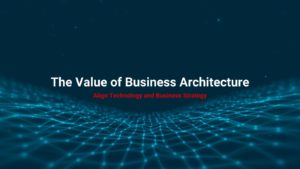Over the course of the next several weeks, I’ll be sharing with CIOs and IT leaders in our community some perspective, principles, and practices. My book, Blind Spot: A Leader’s Guide To IT-Enabled Business Transformation, is written for business leaders to understand the IT transformation journey in very simple business terms. I’ll be using the framework – WHY, WHAT, HOW, WHO – from the book, enhanced with stories and analogies, to give you an easy language to share with your business partners, especially in Finance and HR. I will repeat some things here to set the context so that anyone reading this can pick it up, understand, embrace, and share it with others, regardless of whether they’ve read any of my other blog posts or books.
My hope is that this helps among IT, Finance, HR, and other business leaders so that there is a broader dialogue within your companies and across the companies in our Feld Group Institute community.
Part 1: WHY the Time is NOW.
Everyone now gets the WHY change imperative. Over the last several months, amid constant and accelerating change, the COVID-19 crisis has vividly shown us that being flexible is necessary to SURVIVE and THRIVE. The time is NOW for all leaders to get serious about the “Digital Transformation” that will enable us to institutionalize that business agility. The strategy (the WHY and the WHAT) to compete in the modern era is the responsibility of the entire executive team, however, the CIO, CFO, and the CHRO have unique roles in enabling execution.
IT, Finance, and HR Leaders Must Step Up to Enable Change
Six decades ago, Information Technology started out, in most companies, as a back-office, overhead department that developed functional solutions, mostly in Finance and Accounting, in response to business groups’ requests and focused on processing efficiency. I know that because I was there. Over time, the role of IT has evolved to become a more pervasive enabler across all aspects of the business – including customer-facing and revenue-generating functions. In the Digital Era, departmental or Functional Excellence and continuous improvement are still important but are only table stakes (necessary but not sufficient). Continuous TRANSFORMATION capabilities and Cross-Functional Integration within and across business units, up and down an organization’s management hierarchy, between the front-line and senior leaders, among customers and employees, and across partner ecosystems are the differentiators. Technology is rapidly becoming the “Digital Fabric” that enables the integration for a cohesive, agile enterprise.
During the Industrial Era, it became well understood that the companies with the best financial flexibility and talent dominated their industries. Going forward, you would have to add the best technology as the third enabler required to THRIVE in the future. These enablers are the HOW and the WHO that complete the Blind Spot framework.
- The CIO owns the HOW – architecture, integration, modernization.
- The CFO owns the other part of the HOW – the allocation, level, and pace of the investments and the value commitment realization.
- The CHRO, as the steward of the organization, workforce, talent, and culture, owns the WHO.
Therefore, now, more than ever, we need IT, Finance, and HR leaders and their organizations to step up together to be leaders among their peers. There needs to be a shared responsibility across three special leaders, CIO, the CFO, and the CHRO (“The CIO’s two best friends should be the CFO and the CHRO”). I believe it’s the evolving role and responsibility of the CIO to make sure this teamwork happens. As we get through the crisis and things begin to stabilize, we need to pick back up on (or begin) the conversation with the CFO and the CHRO about how the most successful companies will win in the Modern Digital Era – with the best technology and the best financial and human capital.
The Slingshot Effect
As the pandemic first hit us in March and April, I wrote a series of blog posts called THRIVING IN DYNAMIC TIMES: TURNING HEADWINDS INTO TAILWINDS. In that series, I shared my thoughts on several important topics like leadership, demand shaping, reshaping the workforce, busting the bureaucracy, portfolio modernization, and enterprise architecture. I addressed two perspectives we have to balance – SURVIVE in the short-term (“Go Short”) and the THRIVE over time in the long-term (“Go Long”). Now, while we surely continue to cope with and SURVIVE the ongoing crisis, it’s also time to make sure we recognize that it’s “game on” for the transformation required to THRIVE.
Prior to the crisis, some companies had their heads in the sand, others had bought into the hype but hadn’t started to really do much, others had begun their “Digital Transformation” journey. The overall fundamental mandate for digital transformation in the modern era has not been slowed by COVID-19. In fact, we’ve got to recognize the accelerating pace of change that’s been caused by the crisis. On the other side of COVID-19 and its impacts, the future will be here sooner than expected. This “the slingshot effect” is why we all feel so disoriented about the future.
Now, we’ve all seen the future of the “Modern Era” become more urgent and intense in just the last 2-3 months. Online shopping, banking, learning, entertainment, meetings, customer self-service, etc. are not new. The need for companies to grow revenue, pivot amid rapid change, become more innovative, efficient, and productive, bend the cost curve, etc. are not new. All of these dynamics were all evolving. Now they’ve all accelerated in some amazing ways.
The biggest lasting change won’t be the doom and gloom of COVID-19. We’re going to emerge from the current crisis mode sometime soon, and the digital era will have catapulted us forward to 2023. So, now it’s time to not only sustain but also to increase and accelerate Digital Transformation.
As soon as possible, using what we’ve all learned so clearly in the last few months, recalibrate your Current State (fact-based), Future Vision (imagined), and roadmap or Gap Closing Plan (applying necessary constraints) – at least at a high level. Align with your leadership team and key business partners to update, course correct, or begin your multi-year business transformation plan. From there, begin to re-engage in investment and change programs to drive the transformation with renewed urgency and clarity.
The Leader’s Choice is No Longer a Choice
We’ll only have one chance to do it right. There are no more “mulligans” or “do-overs” or “get to it tomorrows”. Those who don’t get on it now will find themselves really out of position as the future shows up even sooner and faster than we ever anticipated pre-COVID-19. As leaders, especially as leaders of IT, Finance, and HR, we have a huge opportunity and responsibility. No doubt, the wind is always blowing in a crisis. It’s a question of how we set our sails as to whether it’s a headwind or tailwind. Those who lead through this crisis will have a chance of jumping ahead of the curve on the bigger transformational journey. There really isn’t a choice anymore. If not now, then when? If not us, the CIOs, CFOs, and CHROs, then who?
In the blog posts to come in the rest of this series, I’ll be focusing on the details, stories, and principles in each of part of the framework – the WHY, WHAT, HOW, and WHO.
Author: Charlie Feld, Founder and CEO, The Feld Group Institute




